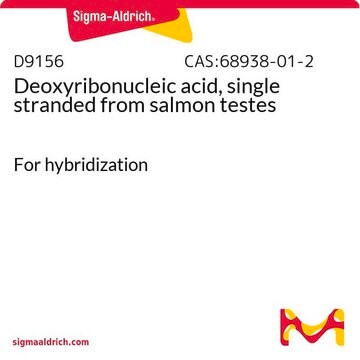L6883
Lithium acetate dihydrate
reagent grade
Sinonimo/i:
Acetic acid lithium salt
About This Item
Prodotti consigliati
Grado
reagent grade
Forma fisica
solid
Composizione
Lithium acetate, ≥63%
pH
≤9.5 (5% in solution)
Punto di fusione
53-56 °C (lit.)
Anioni in tracce
chloride (Cl-): ≤0.003%
sulfate (SO42-): ≤100 ppm
Cationi in tracce
Fe: ≤20 ppm
Na: ≤50 ppm
Stringa SMILE
[Li+].[H]O[H].[H]O[H].CC([O-])=O
InChI
1S/C2H4O2.Li.2H2O/c1-2(3)4;;;/h1H3,(H,3,4);;2*1H2/q;+1;;/p-1
IAQLJCYTGRMXMA-UHFFFAOYSA-M
Cerchi prodotti simili? Visita Guida al confronto tra prodotti
Categorie correlate
Descrizione generale
Applicazioni
- Carbon-modified nanocrystalline LiFePO4 (LiFePO4/C) via sol-gel method using ferrous sulfate, phosphoric acid, citric acid, and polyethylene glycol.
- Lithium-graphite nanotubes (LGN) by chemical vapor deposition (CVD) method in the presence of copper with methane as the carbon source.
- Conductive polycrystalline solid-state electrolyte (Li4B7O12Cl) by reacting with boric acid and copper(II) chloride dihydrate in trihexyltetradecylphosphonium chloride via an ionothermal method.
It can also be used as a catalyst in the enantioselective synthesis of functionalized 1,3-thiazin-4-ones via N-heterocyclic carbene (NHC)-catalyzed [3 + 3] annulation of thioamides.
Codice della classe di stoccaggio
11 - Combustible Solids
Classe di pericolosità dell'acqua (WGK)
WGK 1
Punto d’infiammabilità (°F)
Not applicable
Punto d’infiammabilità (°C)
Not applicable
Certificati d'analisi (COA)
Cerca il Certificati d'analisi (COA) digitando il numero di lotto/batch corrispondente. I numeri di lotto o di batch sono stampati sull'etichetta dei prodotti dopo la parola ‘Lotto’ o ‘Batch’.
Possiedi già questo prodotto?
I documenti relativi ai prodotti acquistati recentemente sono disponibili nell’Archivio dei documenti.
I clienti hanno visto anche
Il team dei nostri ricercatori vanta grande esperienza in tutte le aree della ricerca quali Life Science, scienza dei materiali, sintesi chimica, cromatografia, discipline analitiche, ecc..
Contatta l'Assistenza Tecnica.






